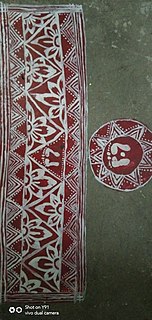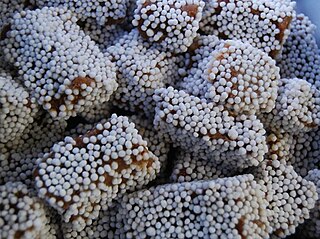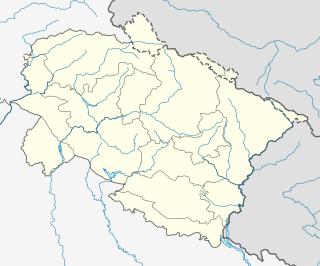 W
WAdvaita Ashrama, Mayavati, is a branch of the Ramakrishna Math, founded on 19 March 1899 at the behest of Vivekananda, by his disciples James Henry Sevier, and Charlotte Sevier. Today it publishes the original writings of Vivekananda. As an ashram dedicated to the study and practice of Advaita Vedanta, no images or idols are worshipped there, not even of Ramakrishna; and no images were kept in the premises according to the Ashram ideals set by Vivekananda.
 W
WAipan art is an established-ritualistic folk art originating from the state of Uttarakhand. The art is done mainly during special occasions, household ceremonies and rituals. Practitioners believe that it invokes a divine power which brings about good fortune and deters evil. The art is special as it is done on empty walls, which are brick-red in color, called Geru. The actual art is done with a white paste made of rice flour. The art is frequent to floors and walls of Puja rooms and entrances of homes. It is also practiced mostly by women. The art form has great social, cultural and religious importance.
 W
WBal mithai is a brown chocolate-like fudge, made with roasted khoa, coated with white sugar balls, and is a popular sweet from the Himalayan state of Uttarakhand in India, especially regions around Kumaon.
 W
WBarechhina near petrol pump 263624 is a village in Almora district, Uttarakhand, 18 km from the district headquarters, the city of Almora. . It lies on highway from Almora-Barechhina-Dhaulchina-Sheraghat-RaiAgar-Berinag-Chaukori-Thal-Tejam to Munsiyari.
 W
WMadhuri Uniyal Barthwal is an Indian folk singer. She was the woman to be a composer on All India Radio. She was said to be the first Garhwali musician to become a music teacher. On International Women's Day in 2019 she was awarded the Nari Shakti Puraskar by Ram Nath Kovind.
 W
WBasanti Bisht is a well known folk singer of Uttarakhand, famous for being the first woman singer of the Jagar folk-form of Uttarakhand. The Jagar form of singing is a way of invoking deities, which is traditionally done by men but, Basanti Bisht broke the practice and today is a well-known voice, and is trying to preserve this traditional form of singing. Basanti Bisht was awarded the Padma Shri in 2017.
 W
WChholiya is a dance form practised in the Kumaon division of Uttarakhand, India. It is basically a sword dance accompanying a marriage procession but now it is performed on many auspicious occasions.
 W
WChitai or Jethai is a village on the Almora-Pithoragarh highway, 6 kilometres (3.7 mi) from Almora in Uttarakhand state, India. It is known for the temple of Golu Devata.
 W
WJageshwar Temples, also referred to as Jageswar Temples or Jageshwar Valley Temples, are a group of over 100 Hindu temples dated between 7th and 12th century near Almora, in the Himalayan Indian state of Uttarakhand. The valley has a number of temple clusters such as the Dandeshwar and Jageshwar sites. Some locations have attracted construction of new temples through the 20th-century. Together these clusters over the valley consist of over 200 structural temples built from cut stone. Many are small, while a few are substantial. They predominantly illustrate North Indian Nagara style of architecture with a few exceptions that show South and Central Indian style designs, many are dedicated to god Shiva, while others in immediate vicinity are dedicated to god Vishnu, Shakti goddesses and Surya traditions of Hinduism.
 W
WThe Kānvar Yātrā is an annual pilgrimage of devotees of Shiva, known as Kānvarias(कावड़िया) or "Bhole" (भोले), to Hindu pilgrimage places of Haridwar, Gaumukh and Gangotri in Uttarakhand and Sultanganj in Bihar to fetch holy waters of Ganges River. Millions of participants gather sacred water from the Ganga and carry it across hundreds of miles to dispense as offerings in their local Śiva shrines, or specific temples such as Pura Mahadeva and Augharnath temple in Meerut, and Kashi Vishwanath, Baidyanath, and Deoghar in Jharkhand.
 W
WKumauni cuisine is the food of the Kumaon region of Uttarakhand, India. Kumaoni food is very simple and nutritious. It completely suits the hard environment of the Himalayas. Pulses like gehet are fashioned into different preparations like, Kumaoni raitaa, Bal Mithai ,ras bhaat, chains, faanda and thatwaani. All are unique preparations from the same pulse. Jholi or curry seasoned with curd. Chudkani and Joula made from bhatt pulses. Cereals like Mandua with rice and wheat are popular,
 W
WMirtola, also known as ‘Uttar Vrindavan’ is a village 10 km. away from Almora, in Uttarakhand state in India, most known for an ashram by the same name, set up by Sri Yashoda Ma, a housewife turned ascetic in the 1930, along with her disciple Sri Krishna Prem (1898–1965), a mystic of the 20th Century. The ashram was later run by his disciple, Sri Madhava Ashish (1920–1997), another Englishman, who also later settled in India.
 W
WMountain Temples and Temple Mountains: Architecture, Religion, and Nature in the Central Himalayas is a 2019 book by art historian Nachiket Chanchani, associate professor at University of Michigan, Ann Arbor, that provides a complete historical survey of temple architecture in the Indian state of Uttarakhand, and explores how the Central Himalaya region, home to many pilgrimage sites, came to acquire immense religious significance for Hindus. It is the first complete art historical and architectural survey of the under-studied region.
 W
WThe folk music of Uttarakhand refers to the traditional and contemporary songs of Kumaon and Garhwal regions in the foothills of Himalayas. This music has its root in the lap of nature and the hilly terrain of the region.
 W
WPahari painting is an umbrella term used for a form of Indian painting, done mostly in miniature forms, originating from Himalayan hill kingdoms of North India, during 17th-19th century, notably Basohli, Mankot, Nurpur, Chamba, Kangra, Guler, Mandi, and Garhwal. Nainsukh was a famous master of the mid-18th century, followed by his family workshop for another two generations.
 W
WRamlila (Rāmlīlā) is any dramatic folk re-enactment of the life of Rama according to the ancient Hindu epic Ramayana or secondary literature based on it such as the Ramcharitmanas. It particularly refers to the thousands of Hindu god Rama-related dramatic plays and dance events, that are staged during the annual autumn festival of Navratri in India. After the enactment of the legendary war between Good and Evil, the Ramlila celebrations climax in the Dussehra night festivities where the giant grotesque effigies of Evil such as of demon Ravana are burnt, typically with fireworks.